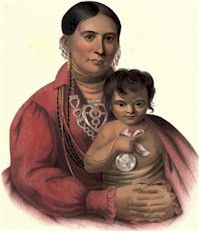Osage Indians. A corruption of their own name Wazhazhe, which in turn is probably an extension of the name of one of the three bands of which the tribe is composed. Also called:
- Anahou, a name used by the French, perhaps the Caddo name.
- Bone Indians, given by Schoolcraft.
The Osage were the most important tribe of the division of the Siouan linguistic stock called by J. O. Dorsey (1897) Dhegiha, which included also the Omaha, Ponka, Kansa, and Quapaw.
Osage Locations
The greater part of this tribe was anciently on Osage River, Mo., but from a very early period a smaller division known as Little Osage was on the Missouri River near the village of the Missouri Indians. (See also Arkansas, Kansas, and Oklahoma.)
Osage Villages

Osage Woman with child
The two principal local divisions were the Great and Little Osages, mentioned above. About 1802 a third division, the “Arkansas Band,” was created by the migration of nearly half of the Big Osage to Arkansas River under a chief known as Big. Track. The names of the following Osage villages, some of them having the names of their chiefs, have been recorded:
- Big Chief, 4 miles from the Mission in Indian Territory in 1850.
- Black Dog, 60 miles from the Mission in Indian Territory in 1850.
- Heakdhetanwan, on Spring Creek, a branch of Neosho River, Indian Territory.
- Intapupshe, on upper Osage River about the mouth of Sac River, Missouri.
- Khdhasiukdhin, on Neosho River, Kansas.
- Little Osage Village, on Osage Reservation, Oklahoma, on the west bank of Neosho River.
- Manhukdhintanwan, on a branch of Neosho River, Kansas.
- Nanzewaspe, in Neosho valley, southeastern Kansas.
- Nikhdhitanwan, at the junction of the Sac and Osage Rivers, Missouri.
- Paghuukdhinpe, on the east side of Verdigris River, Oklahoma.
- Pasukdhin, an ancient village name and also name of a late village on Verdigris River, Oklahoma.
- Santsepasu, location uncertain.
- Santsukhdhin, native name of the Arkansas band, the village being located on Verdigris River, Oklahoma, 60 miles above its mouth.
- Takdheskautsiupshe, unidentified.
- Tanwakanwakaghe, at the junction of Grand and Osage rivers, Missouri.
- Tanwanshinka, on Neosho River, Oklahoma.
- Wakhakukdhin, on Neosho River, Oklahoma.
- White Hair’s Village, on the east side of Little Osage River in the northern part of the present Vernon County, Missouri.
History of the Osage Indians

Tradition indicates a prehistoric seat of the Osage on the Ohio River, but the first historical notice of them appears to be on Marquette’s autograph map of 1673, where they are located in the region with which they are usually associated. They continued there until the separation of the Arkansas band already mentioned. By that time the Little Osage had moved from the Missouri to a position within 6 miles of the Great Osage. During the eighteenth century and the first part of the nineteenth, the Osage were at war with practically all the other tribes of the Plains and a large number of those of the woodlands, to many of which their name was a synonym for enemy. On November 10, 1808, the Osage signed a treaty ceding all their territorial claims in the present States of Missouri and Arkansas to the United States. The remainder was further curtailed by treaties signed in 1825, 1839, and 1865, and the limits of their later reservation were established by act of Congress of July 15, 1870. They have since been allotted land in severalty and are now citizens of Oklahoma.
Population. Mooney’s (1928) estimate of Osage population as of the year 1780 is 6,200. In 1804 Lewis and Clark estimated 500 warriors in the Great Osage band, nearly half as many Little Osages, and 600 in the Arkansas band. Sibley (1832), about the same time, gave 1,250 warriors. Morse (1822) estimated that there was an Osage population of 5,200; in 1829 Porter gave 5,000; in 1843 the United States Indian Office enumerated 4,102; Schoolcraft (1851-57) records 3,758 exclusive of an important division known as Black Dog’s band; in 1877 the United States Indian Office had 3,001; in 1884, 1,547; in 1886, 1,582; and in 1906, 1,994. The census of 1910 gives 1,373, all but 28 in Oklahoma, but the United States Indian Office Report for 1923 has 2,099. In 1930, 2,344 were reported, and in 1937, 3,649.
Connection in which the Osage Indians have become noted
As above stated, the Osage attained a high reputation as fighters among all the tribes of the southern Plains and many of those of the Gulf region. They are also remarkable for their social organization as set forth in the reports of Dr. Francis La Flesche (1921, 1925, 1928). The name became affixed to the Osage River, a considerable branch of the Missouri, which rises in Kansas but flows principally through the State of Missouri; also to counties in Kansas and Missouri; a fork of the Gasconade River, Mo.; a creek in Arkansas; and to places in Carroll County, Ark.; Franklin County, Ill.; Mitchell County, Iowa; Becker County, Minn.; Osage County, Okla.; Coryell County, Tex.; Monongalia County, W. Va.; Weston County, Wyo.; Osage Beach in Camden County, Mo.; Osage City in Cole County, Mo.; and Osage City in Kansas. Indirectly they have also furnished one of the popular names of the bois d’art, Osage orange, the favorite wood for making bows among the tribes of the southern Plains between the lower Mississippi and the Pueblo country.
